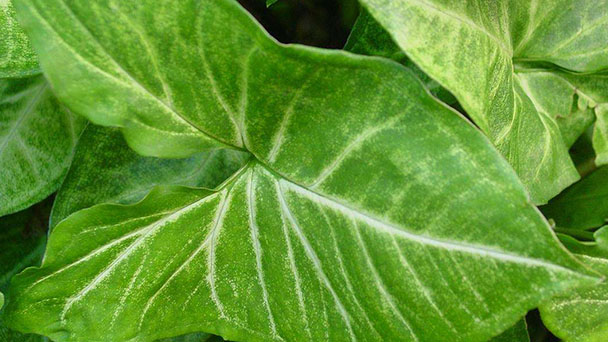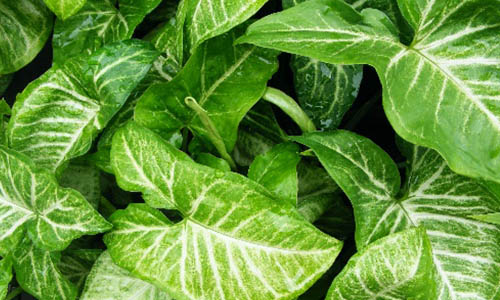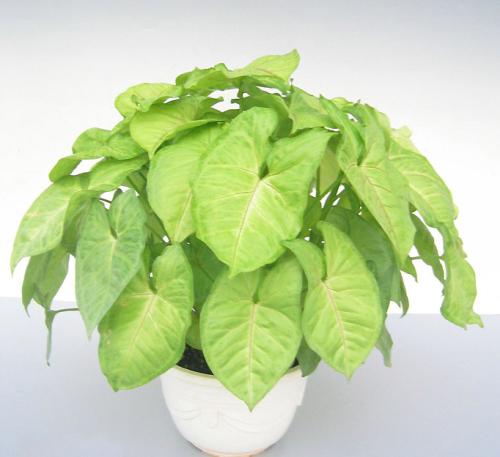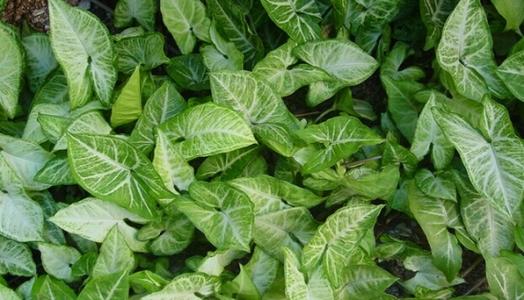Syngonium Podophyllum Schott profile
Written by Maggie
Mar 30 2021

Syngonium Podophyllum Schott, common name rrowhead plant, arrowhead vine, arrowhead philodendron, goosefoot, African evergreen, and American evergreen, is a perennial evergreen vine of the Genus Araceae. Native to tropical America, its leaves have harmonious colors and are very suitable for indoor potted plants for people to enjoy. The great thing about Syngonium Podophyllum Schott is that its leaf shape and leaf color change with the environment, which is very interesting.
Syngonium Podophyllum Schott picture

Syngonium Podophyllum Schott morphological characteristics
Syngonium Podophyllum Schott was fascinated when young, and the posterior stem elongated to liana. Leaves are with long stalks, lower with leaf sheaths. The arrowhead - shaped, green-splotched syngonium podophyllum schott is designed for indoor company and is well suited to bright indoor conditions, where hot outdoor sunlight burns its leaves. Leaves are wider than arrow-shaped fruit taro, thin, green, white green in the middle, green at the back, about 16 cm long, about 9 cm wide. Its leaves are special in that the shape of the leaves changes as the struts grow. Young plants with new leaves are in the shape of halberds or arrows. Older plants, on the other hand, are often mistaken for two different plants because their leaves take the shape of three to five slits. Syngonium Podophyllum Schott prefers a high temperature, wet and semi-cloudy environment. Its leaf shape is unique, shaped like a butterfly wing, so-called white butterfly.
Growth environment and distribution of Syngonium Podophyllum Schott
Syngonium Podophyllum Schott is generally extremely negative tolerant, growing indoors where there is scattered sunlight. But variegated leaves of the fruit arrowhead need sufficient light, spots will not disappear. So syngonium Podophyllum Schott is suitable for oblique lighting. As for sunshine tolerance, it is suitable for half sunshine in infancy and full sunshine in adulthood. However, the summer sunshine is too fierce, so it is necessary to take shade measures at noon and avoid direct sunlight.
Syngonium Podophyllum Schott prefers a hot and humid environment. Spring, summer, autumn is its growth period, and we should often keep the basin soil moist. Winter is its dormant period. syngonium podophyllum Schott grows rapidly, so it is best to change pots every year to facilitate new root growth. Basin-soil is best served with well-drained sandy loam or mixed with snake sawdust with peat moss.
Syngonium Podophyllum Schott distribution: Tropical America and subtropical China.
How to grow and care for Syngonium Podophyllum Schott
Light care
The arrowhead plant does properly in medium to low mild settings and thrive in bright, oblique light. Syngonium Podophyllum Schott do no longer like publicity to direct sunlight. If you are solely capable to grant medium to decrease mild conditions, you may also do higher with one of the deeper inexperienced cultivars. These have a tendency to do higher in shaded conditions.Water care
The soil combine have to be saved gently moist at some stage in spring and summer season and barely drier all through the fall and wintry weather months. Don't let it grow to be absolutely dry. The Syngonium Podophyllum Schott is simple when it comes to watering, however does opt for excessive humidity, so it's a correct thinking to region container flora on a mattress of moist pebbles. Mist putting baskets frequently. Water fairly for the duration of the developing season and decrease watering for the duration of cooler months.Temperature care
As a semi-tropical vine, arrowheads decide on warm, humid conditions. Try no longer to permit temperatures to drop beneath 60° tiers Fahrenheit.Soil care
Use a wealthy potting combine that affords gold standard draining and aerating capabilities.Fertilizer care
Feed the use of a balanced liquid houseplant meals on a ordinary foundation all through the spring and summer time developing season. Follow package deal instructions closely.Syngonium Podophyllum Schott pests and diseases
Syngonium Podophyllum Schott is hardy vegetation have no pests or disorder troubles when cared for properly. Maintain a reasonable watering agenda and grant the proper type of substrate to prevent:How to propagate Syngonium Podophyllum Schott
1. Plant division propagation
Syngonium Podophyllum Schott has a strong growth capacity and is usually planted after 2-3 years of culture.It is best to do this in the spring when you are repotting, dividing the plants with roots into two or more clumps. Prepare suitable soil for it to grow, disinfect the cut and plant it separately in a pot.
2. Tissue culture propagation
This method of propagation is mainly carried out with the side bud or the tip of the stem, which also needs to be disinfected before planting. Rooting water can be used to help it grow new roots, and in about 20 to 25 days Syngonium Podophyllum Schott will grow into a small plant with complete roots.
3. Cutting propagation
This is a common method. The base of the plant usually has many branches. When the branches have produced three or four leaves, cut off the branches above the second section. The length of the cuttings can be about 10cm. Prepare a breathable substrate and insert the cuttings into the soil to create a rooting environment of about 25 ° C. After Syngonium Podophyllum Schott has sprouted, it can be transplanted.

Syngonium Podophyllum Schott main value
Syngonium Podophyllum Schott is mainly used as an indoor ornamental leaf pot for hanging, hanging, water cultivation and wall hanging decoration. In warm areas, it can be used as a hedge and corner, background, climbing wall and paving material. Syngonium Podophyllum Schott is beautiful and varied, suitable not only for potted plants but also for bonsai making. It is a representative indoor ornamental plant. It is also used in potted plants or basket plants, as hanging decoration materials. The Syngonium Podophyllum Schott leaf is also used in flower arrangement. It can also be grown on shaded walls or at the edge of flower beds.

Latest Updated
- Benefits of Bugleweed - 7 Science-backed Health Benefits
- Bugleweed Dangers & Side Effects - Is It Poisonous?
- How to Plant Evergreen Trees - What You Should Know
- When to Plant Evergreens - Grow Guide for Evergreen Trees
- 12 Wonderful Evergreen Shrubs for Your Garden
- 12 Popular Evergreen Plants with Pictures for Beginners
- When And How To Prune A Lilac Bush Like a Pro
- How to Grow & Care for Lilac Vine (Hardenbergia Violacea)
- Japanese Lilac Tree (Syringa Reticulata) Care & Propagation Guide
- Shumard Oak Pros and Cons - What to Know
Popular Articles
- Winter maintenance of Antirrhinum Majus
- How to Grow Terminalia Mantaly Tree
- How to Grow and Care for Crossostephium Chinense
- How to grow Antirrhinum Majus in spring
- Peristeria Elata (Dove Orchid) Profile: Info & Care Guide
- Underwatered Snake Plant (Sansevieria Trifasciata) - Signs And How To Fix
- How to Care for Brazilian Jasmine Plant (Mandevilla Sanderi)
- How to Grow & Care for Graptopetalum Purple Delight in Summer
- Rosa Chinensis (China Rose): Plant Growing & Care Tips
- How to Care for Baby Sun Rose (Aptenia Cordifolia)